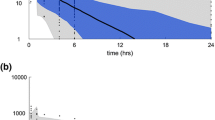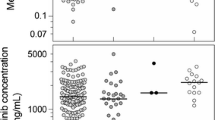Abstract
Purpose
The present study aimed to investigate the role of expression of daunorubicin-metabolizing enzymes carbonyl reductase 1 and 3 (CBR1 and CBR3) on the in vitro cytotoxicity of daunorubicin in primary acute myeloid leukemia (AML) cells and the effect of genetic variants in CBR1 and CBR3 on the plasma pharmacokinetics of daunorubicin and daunorubicinol (DOL) in AML patients.
Methods
RNA expression of CBR1 and CBR3, intracellular daunorubicin and DOL levels, and in vitro cytotoxicity of daunorubicin were measured in bone marrow mononuclear cells of 104 adult AML patients. Plasma pharmacokinetics of daunorubicin and DOL was measured in 24 patients receiving daunorubicin-based induction chemotherapy for AML.
Results
Increased expression of CBR1 significantly reduced the in vitro cytotoxicity of daunorubicin and also positively correlated with intracellular DOL levels. Polymorphisms in CBR1 and CBR3 did not show any association with intracellular daunorubicin or DOL levels, but there was a trend towards significant increase in plasma daunorubicin systemic exposure in patients with a variant genotype for CBR1 polymorphism rs25678.
Conclusions
This pilot study suggests that CBR1 RNA expression may be helpful in identifying AML patients at risk of developing resistance or toxicity to daunorubicin due to increased formation of DOL. Further confirmation of these findings in a larger sample pool would be required to determine the applicability of these results. Inhibition of CBR1 can be an option to improve the efficacy and prevent toxicity related to the treatment. Influence of daunorubicin and DOL plasma levels on clinical outcome, if any, remains to be evaluated.





Similar content being viewed by others
References
Weiss RB (1992) The anthracyclines: will we ever find a better doxorubicin? Semin Oncol 19(6):670–686
Rabbani A, Finn RM, Ausio J (2005) The anthracycline antibiotics: antitumor drugs that alter chromatin structure. Bioessays 27(1):50–56
Frohling S, Scholl C, Gilliland DG, Levine RL (2005) Genetics of myeloid malignancies: pathogenetic and clinical implications. J Clin Oncol 23(26):6285–6295
Schiffer CA, McIntyre OR (1993) Age related changes in adults with acute leukemia. Adv Exp Med Biol 330:215–229
Burnett AK, Mohite U (2006) Treatment of older patients with acute myeloid leukemia–new agents. Semin Hematol 43(2):96–106
Kuffel MJ, Reid JM, Ames MM (1992) Anthracyclines and their C-13 alcohol metabolites: growth inhibition and DNA damage following incubation with human tumor cells in culture. Cancer Chemother Pharmacol 30(1):51–57
Oppermann U (2007) Carbonyl reductases: the complex relationships of mammalian carbonyl- and quinone-reducing enzymes and their role in physiology. Annu Rev Pharmacol Toxicol 47:293–322
Plebuch M, Soldan M, Hungerer C, Koch L, Maser E (2007) Increased resistance of tumor cells to daunorubicin after transfection of cDNAs coding for anthracycline inactivating enzymes. Cancer Lett 255(1):49–56
Takahashi RH, Bains OS, Pfeifer TA, Grigliatti TA, Reid RE, Riggs KW (2008) Aldo-keto reductase 1C2 fails to metabolize doxorubicin and daunorubicin in vitro. Drug Metab Dispos 36(6):991–994
Kassner N, Huse K, Martin HJ, Godtel-Armbrust U, Metzger A, Meineke I et al (2008) Carbonyl reductase 1 is a predominant doxorubicin reductase in the human liver. Drug Metab Dispos 36(10):2113–2120
Forrest GL, Gonzalez B (2000) Carbonyl reductase. Chem Biol Interact 129(1–2):21–40
Watanabe K, Sugawara C, Ono A, Fukuzumi Y, Itakura S, Yamazaki M et al (1998) Mapping of a novel human carbonyl reductase, CBR3, and ribosomal pseudogenes to human chromosome 21q22.2. Genomics 52(1):95–100
Liu S, Ma L, Huang W, Shai Y, Ji X, Ding L et al (2006) Decreased expression of the human carbonyl reductase 2 gene HCR2 in hepatocellular carcinoma. Cell Mol Biol Lett 11(2):230–241
Gonzalez B, Akman S, Doroshow J, Rivera H, Kaplan WD, Forrest GL (1995) Protection against daunorubicin cytotoxicity by expression of a cloned human carbonyl reductase cDNA in K562 leukemia cells. Cancer Res 55(20):4646–4650
Huang W, Ding L, Huang Q, Hu H, Liu S, Yang X et al (2010) Carbonyl reductase 1 as a novel target of (-)-epigallocatechin gallate against hepatocellular carcinoma. Hepatology 52(2):703–714
Bogason A, Masquelier M, Lafolie P, Skogastierna C, Paul C, Gruber A et al (2010) Daunorubicin metabolism in leukemic cells isolated from patients with acute myeloid leukemia. Drug Metab Lett 4(4):228–232
Gonzalez-Covarrubias V, Ghosh D, Lakhman SS, Pendyala L, Blanco JG (2007) A functional genetic polymorphism on human carbonyl reductase 1 (CBR1 V88I) impacts on catalytic activity and NADPH binding affinity. Drug Metab Dispos 35(6):973–980
Bains OS, Karkling MJ, Grigliatti TA, Reid RE, Riggs KW (2009) Two nonsynonymous single nucleotide polymorphisms of human carbonyl reductase 1 demonstrate reduced in vitro metabolism of daunorubicin and doxorubicin. Drug Metab Dispos 37(5):1107–1114
Lakhman SS, Ghosh D, Blanco JG (2005) Functional significance of a natural allelic variant of human carbonyl reductase 3 (CBR3). Drug Metab Dispos 33(2):254–257
Blanco JG, Leisenring WM, Gonzalez-Covarrubias VM, Kawashima TI, Davies SM, Relling MV et al (2008) Genetic polymorphisms in the carbonyl reductase 3 gene CBR3 and the NAD(P)H:quinone oxidoreductase 1 gene NQO1 in patients who developed anthracycline-related congestive heart failure after childhood cancer. Cancer 112(12):2789–2795
Fan L, Goh BC, Wong CI, Sukri N, Lim SE, Tan SH et al (2008) Genotype of human carbonyl reductase CBR3 correlates with doxorubicin disposition and toxicity. Pharmacogenet Genomics 18(7):621–631
Lal S, Sandanaraj E, Wong ZW, Ang PC, Wong NS, Lee EJ et al (2008) CBR1 and CBR3 pharmacogenetics and their influence on doxorubicin disposition in Asian breast cancer patients. Cancer Sci 99(10):2045–2054
Kokenberg E, Sonneveld P, Sizoo W, Hagenbeek A, Lowenberg B (1988) Cellular pharmacokinetics of daunorubicin: relationships with the response to treatment in patients with acute myeloid leukemia. J Clin Oncol 6(5):802–812
Poonkuzhali B, Srivastava A, Quernin MH, Dennison D, Aigrain EJ, Kanagasabapathy AS et al (1999) Pharmacokinetics of oral busulphan in children with beta thalassaemia major undergoing allogeneic bone marrow transplantation. Bone Marrow Transplant 24(1):5–11
Bustin SA, Benes V, Garson JA, Hellemans J, Huggett J, Kubista M et al (2009) The MIQE guidelines: minimum information for publication of quantitative real-time PCR experiments. Clin Chem 55(4):611–622
Borg AG, Burgess R, Green LM, Scheper RJ, Liu Yin JA (2000) P-glycoprotein and multidrug resistance-associated protein, but not lung resistance protein, lower the intracellular daunorubicin accumulation in acute myeloid leukaemic cells. Br J Haematol 108(1):48–54
Fogli S, Danesi R, Innocenti F, Di Paolo A, Bocci G, Barbara C et al (1999) An improved HPLC method for therapeutic drug monitoring of daunorubicin, idarubicin, doxorubicin, epirubicin, and their 13-dihydro metabolites in human plasma. Ther Drug Monit 21(3):367–375
Pieters R, Loonen AH, Huismans DR, Broekema GJ, Dirven MW, Heyenbrok MW et al (1990) In vitro drug sensitivity of cells from children with leukemia using the MTT assay with improved culture conditions. Blood 76(11):2327–2336
Klumper E, Pieters R, Kaspers GJ, Huismans DR, Loonen AH, Rottier MM et al (1995) In vitro chemosensitivity assessed with the MTT assay in childhood acute non-lymphoblastic leukemia. Leukemia 9(11):1864–1869
D'Argenio DZ, Schumitzky A, Wang X (2009) ADAPT 5 user's guide: pharmacokinetic/pharmacodynamic systems analysis software. Biomedical Simulations Resource, Los Angeles
Barrett JC, Fry B, Maller J, Daly MJ (2005) Haploview: analysis and visualization of LD and haplotype maps. Bioinformatics 21(2):263–265
Lewontin RC (1964) The interaction of selection and linkage. I. General considerations; heterotic models. Genetics 49(1):49–67
Hochberg Y, Ba Y (1995) Controlling the false discovery rate: a practical and powerful approach to multiple testing. J R Stat Soc Ser B: Methodol 57(1):11
Speth PA, Linssen PC, Boezeman JB, Wessels HM, Haanen C (1987) Leukemic cell and plasma daunomycin concentrations after bolus injection and 72 h infusion. Cancer Chemother Pharmacol 20(4):311–315
Terada T, Sugihara Y, Nakamura K, Mizobuchi H, Maeda M (2003) Further characterization of Chinese hamster carbonyl reductases (CHCRs). Chem Biol Interact 143–144:373–381
Zhang Y, Rohde C, Tierling S, Jurkowski TP, Bock C, Santacruz D et al (2009) DNA methylation analysis of chromosome 21 gene promoters at single base pair and single allele resolution. PLoS Genet 5(3):e1000438
Gonzalez-Covarrubias V, Zhang J, Kalabus JL, Relling MV, Blanco JG (2009) Pharmacogenetics of human carbonyl reductase 1 (CBR1) in livers from black and white donors. Drug Metab Dispos 37(2):400–407
Bains OS, Karkling MJ, Lubieniecka JM, Grigliatti TA, Reid RE, Riggs KW (2010) Naturally occurring variants of human CBR3 alter anthracycline in vitro metabolism. J Pharmacol Exp Ther 332(3):755–763
Galettis P, Boutagy J, Ma DD (1994) Daunorubicin pharmacokinetics and the correlation with P-glycoprotein and response in patients with acute leukaemia. Br J Cancer 70(2):324–329
Sauna ZE, Kimchi-Sarfaty C, Ambudkar SV, Gottesman MM (2007) Silent polymorphisms speak: how they affect pharmacogenomics and the treatment of cancer. Cancer Res 67(20):9609–9612
Acknowledgments
We gratefully acknowledge the help provided by Dr. Carl J Panetta, Department of Pharmaceutical Sciences, St. Jude Children's Research Hospital, Memphis, TN in checking our noncompartmental PK analysis and providing his valuable input in revising this manuscript. We also acknowledge Dr. Eunice S. Edison and Ms. M. Ezhilpavai for critically reviewing the revised manuscript. This study was supported by the Department of Biotechnology, India, grant no: BT/01/COE/08/03. Ajay Abraham is supported by a grant from the University Grants Commission, India.
Author information
Authors and Affiliations
Corresponding author
Rights and permissions
About this article
Cite this article
Varatharajan, S., Abraham, A., Zhang, W. et al. Carbonyl reductase 1 expression influences daunorubicin metabolism in acute myeloid leukemia. Eur J Clin Pharmacol 68, 1577–1586 (2012). https://doi.org/10.1007/s00228-012-1291-9
Received:
Accepted:
Published:
Issue Date:
DOI: https://doi.org/10.1007/s00228-012-1291-9




